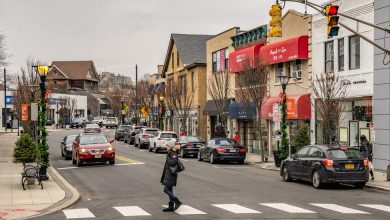Can Schools Handle Omicron?

This is the Education Briefing, a weekly update on the most important news in U.S. education. .
This is our final Education Briefing newsletter for 2021 — and it’s sobering to have to end the year with a look at another wave of Covid, and the toll on the mental health of our students.

Mya Speller, a first grader, offering a socially distanced greeting at Grant Avenue Elementary School in the Bronx, N.Y.Credit…Desiree Rios for The New York Times
Can schools handle Omicron?
Many school districts, and many parents, say they don’t want classrooms to close again. Several major school systems have said they would not shift districtwide to remote learning, or would do so only if forced to by public health officials.
But the looming Omicron wave could challenge the rickety infrastructure that has kept schools running this year. Some classrooms are closing temporarily, as more people test positive or go into quarantine.
“I was not even slightly surprised — I fully expected it,” said Olivia Strong, a parent in Manhattan. Her son’s cohort of eighth graders is shifting to remote learning because of multiple virus cases in his class.
Things have gone relatively smoothly for schools this year, despite targeted classroom closures to contain spread of the virus. School outbreaks have been limited throughout the pandemic, and children are being vaccinated. (Crucially, as my colleague David Leonhardt has repeatedly noted in The Morning newsletter, childhood Covid is almost always mild.)
Across the nation’s 13,000 districts and 98,000 public schools this week, there are about 600 shuttered schools or districts, according to data from Burbio, a company that has tracked how schools have operated through the pandemic. There are fewer closures now than in November.
But the Omicron variant appears contagious enough to upend the shaky equilibrium that has allowed schools to stay open. Many are in dire need of substitute teachers and bus drivers, and can ill afford an outbreak that would send many staff members home.
The C.D.C. has encouraged schools to use a “test-to-stay” protocol, in which people who test negative after exposure can stay in classrooms, reducing quarantines and closures.
But there are still not enough rapid tests to quickly screen whole classrooms or schools. And many parents have not given consent for their children to be tested for the virus at school.
“If there is a positive case in a class, everyone should just get tested,” Erik Berg, vice president of the Boston Teachers Union, said. “If our universities and colleges can test everyone on campus twice per week, it says a lot about the commitment to K-12 education that we can’t even test people we know were in the same room with a positive case for six or seven hours.”
The year in mental health
It hasn’t been easy to be a student during the pandemic. Here’s a look at some of the challenges our kids have faced.
Children
Even as nearly every school opened last fall, teachers had to handle some of the aftereffects of long-term remote schooling.
Some kids were melting down at school. Moms struggled, too. This fall, the number of children in crisis under the age of 13 was increasing.
Over the summer, camp directors bore the brunt of kids’ anxieties. And in schools, nurses are often on the front lines of the mental health crisis, and they’re often overwhelmed by the need.
Let’s not forget that a staggering number of children — at least 120,000, according to a recent study — have lost a parent or a caregiver to Covid-19.
Adolescents
The surgeon general warned this month that young people are facing “devastating” mental health effects as a result of the challenges experienced by their generation, including the coronavirus pandemic.
Remote learning in the last academic year played a part. Few have had a harder time than children coming from immigrant households who rarely speak English at home. Families of color — who have disproportionately borne the impact of the pandemic and the shortfalls of remote learning — are often struggling the most.
“In the more than two decades I’ve spent as a psychologist working with adolescents, I have never seen teenagers so worn down at the end of an academic year as they are right now,” Lisa Damour wrote in The Times this spring.
A survey this summer found that 72 percent of 13- to 19-year-olds have struggled with their mental health. Eating disorders have skyrocketed, too. In a recent survey, about half of middle and high school students in Los Angeles said they worried about their own mental health and that of their families and friends.
Genesis Duran is one of millions of high school seniors whose world has been shaken by the pandemic. She lives in New York City, where she had to help her sister with remote learning while dealing with her own classes, too.
The Coronavirus Pandemic: Key Things to Know
The Omicron variant. The highly transmissible Covid strain appears to be less severe than previous variants, according to new studies. Research also suggests many non-mRNA vaccines offer almost no defense against infection, though the Pfizer and Moderna boosters, which are mRNA-based, likely provide strong protection.
The holiday season. With planned end of the year gatherings, the new Covid surge is prompting worries and cancellations. The Times asked experts to share some holiday guidance, as well as some tips on using at-home Covid tests (if you can find any). Here is what to do if you test positive for Covid.
Biden’s new plan. President Biden announced new steps to confront the surge in Covid cases, including setting up new federal testing sites, readying military medical personnel to help hospitals and buying 500 million rapid tests to distribute free to the public, though experts warned the measures would not stop an Omicron surge.
Around the world. After infections skyrocketed to record levels in South Africa, new cases have started falling, suggesting its Omicron wave may have peaked. In Europe, the Netherlands, Britain and Denmark adopted tough restrictions, while France, Spain and Italy are taking a more measured approach.
My colleague Susan Dominus also looked in one class in Columbia, Mo., where the students and their teacher struggled through the difficult year, stuck in front of their screens.
And the audio team at The Times traveled to Odessa, Texas, where one high school — and its marching band — are fighting to keep students in school, healthy and learning.
College students
This semester, students have been back on campuses. With vaccines, life began to feel a little more normal, at least for some students.
But as the Omicron variant spreads, universities fear a worsening mental health crisis. Many students are isolated and depressed, and at a few institutions, there has been a troubling spate of suicides.
As cases surge, a big question is what campus life will look like in January. Will classes be remote? Will students be able to gather? Will there even be campus life?
During remote schooling last year, some students found that amid the losses, there were some gains, in their unwanted suspension of campus life.
The bright spots in a hard year
More schools are planning to use coronavirus relief money to strengthen mental health resources. And a lot of schools have allowed mental health days, after teenagers pushed for them. Here are tips to make yours worthwhile.
“My 13-year-old soccer-obsessed son asked to miss school for a mental health day,” wrote Holly Roberson, a parent in Berkeley, Calif. “He spent the day in bed, sipping hot chocolate and working on a script for a musical. He said it was the best day of his life.”
Virus news
K-12
-
Los Angeles delayed its plan to require student vaccinations because it did not know what to do with the tens of thousands of students who were still unvaccinated.
-
The Florida Department of Education released the paychecks that it had withheld from school board members who voted for mask mandates.
-
Public schools in Prince George’s County in Maryland became the first major district to shift to remote learning through mid-January.
-
Anchorage, the largest school district in Alaska, will make masks in schools optional in January.
-
A federal appeals court upheld a mask requirement for Knox County Schools, in Tennessee.
-
A judge ruled against San Diego’s student vaccine mandate.
College
-
Institutions are starting to require vaccine boosters, including Dartmouth College, the University of Rhode Island and the University of Oregon.
-
Yale, Princeton and other colleges moved their exams online amid the surge.
What else we’re reading
K-12
-
Third graders in Washington, D.C., were directed to act out scenes from the Holocaust, simulating shootings and the digging of mass graves.
-
Some schools either closed or increased security measures in response to vague warnings of shooting threats circulating on social media.
-
Julia Keleher, Puerto Rico’s former education secretary, was sentenced to prison after she pleaded guilty to conspiracy to commit fraud.
-
A teacher in North Carolina raised more than $100,000 to keep her students fed over winter break.
College
-
The University of Utah is investigating reports of men dressed like the KKK in dorms and excrement smeared on a door of a Black student’s room.
-
A former student at Virginia Commonwealth University pleaded guilty to hazing and serving alcohol to a minor in connection with a 19-year-old freshman’s death.
-
Harvard extended its optional standardized test policy for the next four years. The California State University System is poised to drop the SAT and ACT as an admissions requirement.
-
A professor at the University of Tennessee at Chattanooga hid a clue to find $50 in his syllabus. No one looked for the cash.
-
A professor is cracking down on a number of fraudulent students registering in classes throughout California’s community colleges.
Give us your feedback
As we enter the new year, we want to hear from you. What are you loving? What would you like to see more of? Less of? What are we missing? I’d be so grateful if you answered a quick survey about the briefing. Thank you so much!
Sign up here to get the briefing by email.





